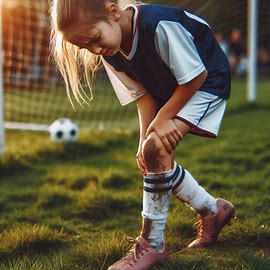Infantile Spasms
April 4, 2024Lactose Intolerance
April 9, 2024Shin Splints

Shin splints, also known as medial tibial stress syndrome, is a common overuse injury that affects children engaged in physical activities, particularly sports and running. While shin splints can cause discomfort and impact a child’s ability to participate in physical activities, understanding its causes, symptoms, and treatment options is essential for effective management.
What are Shin Splints?
Shin splints refer to pain and inflammation along the shinbone (tibia), which is the large bone in the front of the lower leg. This condition occurs when the muscles, tendons, and bone tissue around the shin become overworked or overstressed, often due to repetitive impact or excessive physical activity. While shin splints are typically not a serious injury, they can cause discomfort and limit a child’s ability to engage in sports and other physical activities.
Causes of Shin Splints in Children:
Several factors can contribute to the development of shin splints in pediatric patients, including:
- Overuse or sudden increase in activity: Engaging in high-impact or repetitive physical activities, such as running, jumping, or dancing, without proper conditioning or gradually increasing intensity can strain the muscles and tissues in the lower legs, leading to shin splints.
- Improper footwear: Wearing shoes that lack adequate cushioning or support, or shoes that are worn out or not appropriate for the child’s activity level, can increase the risk of developing shin splints.
- Biomechanical factors: Issues with foot arches, gait mechanics, or lower limb alignment can place excessive stress on the shinbone and surrounding tissues, increasing the likelihood of developing shin splints.
- Poor training techniques: Incorrect running or jumping techniques, such as heel striking or overstriding, can contribute to the development of shin splints by placing excessive strain on the lower legs.
Symptoms of Shin Splints in Children:
The primary symptom of shin splints is pain and tenderness along the inner edge of the shinbone, which may worsen during physical activity and improve with rest. Other common symptoms include:
- Dull, aching pain in the front or inner side of the lower leg
- Swelling or inflammation around the shinbone
- Pain that increases with activity and decreases with rest
- Pain that may be aggravated by touching or pressing on the affected area
- Mild to moderate discomfort during daily activities, such as walking or climbing stairs
It is essential for parents, coaches, and caregivers to recognize these symptoms and seek medical attention if shin splints are suspected in a child.
Treatment and Management of Shin Splints in Children:
Treatment of shin splints in children typically involves a combination of rest, activity modification, and conservative measures to relieve pain and inflammation. Common treatment strategies include:
- Rest: Encouraging the child to rest and avoid activities that exacerbate symptoms is essential for allowing the injured tissues to heal properly. Depending on the severity of symptoms, temporary cessation of sports or physical activity may be necessary.
- Ice therapy: Applying ice packs or cold therapy to the affected area can help reduce pain and inflammation. Parents should instruct their child to apply ice for 15-20 minutes several times a day, especially after physical activity.
- Pain management: Over-the-counter pain relievers, such as ibuprofen or acetaminophen, may be recommended to alleviate discomfort and reduce inflammation. However, parents should consult with a healthcare professional before giving any medication to their child.
- Compression and elevation: Using compression bandages or sleeves can help reduce swelling and provide support to the shin during activity. Elevating the affected leg above heart level when resting can also help reduce swelling and promote healing.
- Gradual return to activity: Once symptoms have resolved, the child can gradually return to sports and physical activities, starting with low-impact exercises and gradually increasing intensity and duration over time.
Prevention of Shin Splints in Children:
Preventing shin splints in children involves implementing strategies to reduce the risk of overuse injuries and promote proper biomechanics during physical activity. Key prevention measures include:
- Gradual progression of activity: Encouraging children to gradually increase the intensity, duration, and frequency of physical activity can help prevent overuse injuries, including shin splints.
- Proper warm-up and cool-down: Incorporating dynamic stretching exercises and a gradual warm-up before physical activity, followed by a cool-down and static stretching routine afterward, can help prepare the muscles and reduce the risk of injury.
- Cross-training: Encouraging children to participate in a variety of sports and activities, rather than focusing exclusively on one sport, can help prevent overuse injuries and promote overall fitness and athleticism.
- Stretching and strengthening exercises: Performing gentle calf stretches and strengthening exercises can help improve flexibility and muscle strength in the lower legs, reducing the risk of future shin splints.
- Proper footwear and equipment: Ensuring that the child wears supportive, well-fitting footwear appropriate for their activity level can help prevent shin splints. Additionally, using shock-absorbing insoles or orthotic inserts may provide additional support and cushioning.
Shin splints are a common overuse injury that can affect children engaged in physical activities, particularly sports and running. By understanding the causes, symptoms, and treatment options for shin splints, parents, coaches, and caregivers can help children manage their symptoms effectively and prevent future injuries.
If you have additional questions about your child’s health please contact our board-certified clinicians by calling 855-576-8745 or booking a telehealth appointment.
